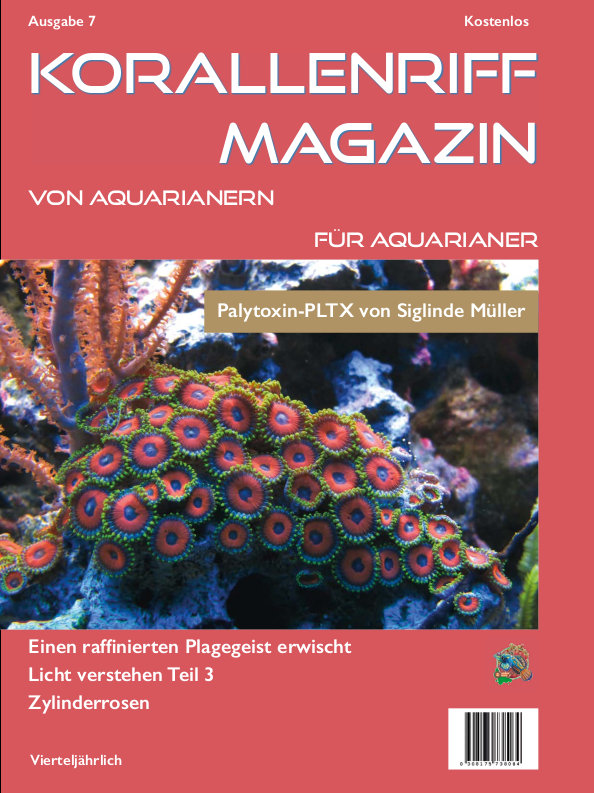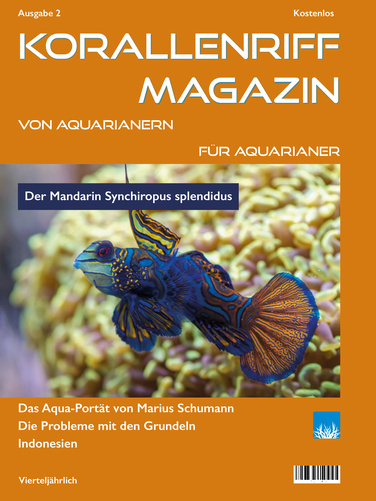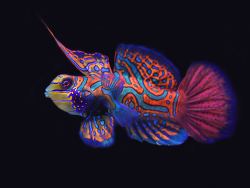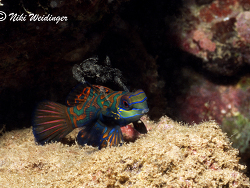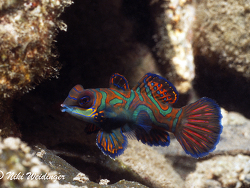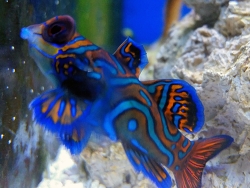Info
The mandarin fish Synchiropus splendidus is placed in the genus Synchiropus within the lyrefish family (Callionymidae). Instead of scales, the mandarin fish has a firm and very slimy skin, which then gives off a foul odor when the fish comes up for air. This layer of mucus on the skin is thought to protect the fish from disease and enemies. Lyrefish do not float or swim like other fish, but move slowly gliding along using their pelvic fins.
Aquarium husbandry recommendation:
This fish can only be kept in well run-in tanks, as it lives on micro animals found in the substrate and on rocks. If you have a well acclimated tank, then there are no problems with feeding. This should be taken to heart.
It is not sensitive to diseases at all. You can recognize the male by the longer first dorsal fin (looks like a small sword) - see picture gallery below.In no case bring two males in one tank, because they would fight each other until death.
Keeping pairs is no problem, even desired. The animals perform a regular courtship dance by rising to the water surface. This is really wonderful to watch.
Feeding intake.
The fish take a long time to eat at the beginning, before the food is taken up, a close inspection is carried out. After acclimatisation, the offered frozen food is eaten without problems. It should be noted that wild-caught fish behave differently than offspring when it comes to food intake. In the case of offspring, the size of the fish purchased also plays a role in the choice of food.
Pool requirement.
The tank volume specified above is less relevant. What is important is that there is enough or suitable food in the tank, because they have to eat constantly and survive without supplementary feeding in well-worn tanks with several months of standing time and correspondingly well-developed microfauna. During this time, they feed on micro-animals found in the substrate and on the stones. There must be enough bottom surface for successful maintenance.
Furthermore, food competitors are also important (e.g. pipefish, small wrasses, etc. or by keeping them in pairs), which chase the limited live food on the substrate. It is also advantageous to keep a small copepod farm (several boxes) in the beginning. After switching to frozen food, live food breeding can be discontinued.
Live benethic (bottom-living) copepods - Tigriopus californicus or Tisbe biminiensis - can always be added if available.
Unfortunately, there is no guarantee that the switch from live food to frozen food will be successful. In this case, extensive live food breeding is necessary for our fish to survive in the aquarium.
There are exceptions that they go to frozen food. However, unfortunately not every Mandarin goes to frozen food, so that it should not be so fresh basins.
We can not share the information of FishBase about 6 cm size, because our fish was already two centimeters bigger.
Breeding information.
The rearing of Synchiropus splendidus larvae has been successful with Acartia (Acanthacartia) tonsa. The nauplii of Acartia are very small (70 µm) and pelagic (free-swimming).
The breeder Wolfang Mai has already succeeded in breeding Synchiropus splendidus. Source: Wolfgang Mai: Lyrefish in the marine aquarium: care and breeding. NTV Nature and Animal Publishing House, 2009
Synonyms:
Callionymus splendidus Herre, 1927
Neosynchiropus splendidus (Herre, 1927)
Pterosynchiropus splendidus (Herre, 1927)







 François Libert, Frankreich
François Libert, Frankreich















